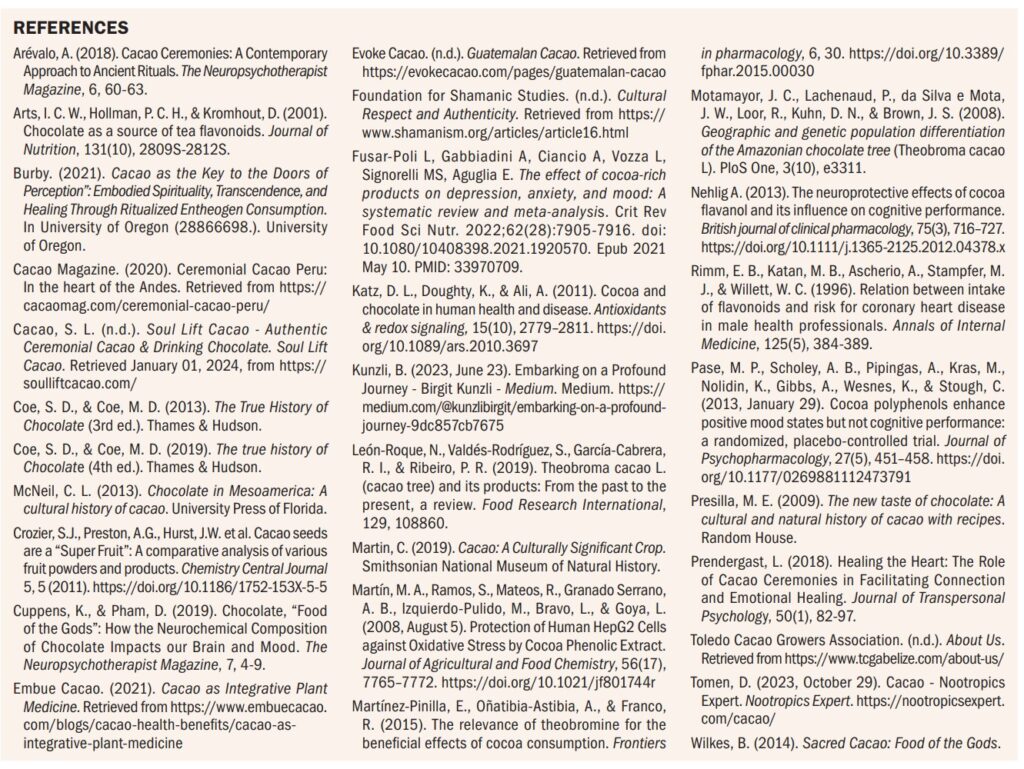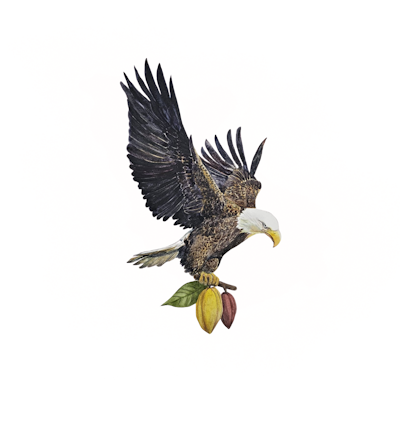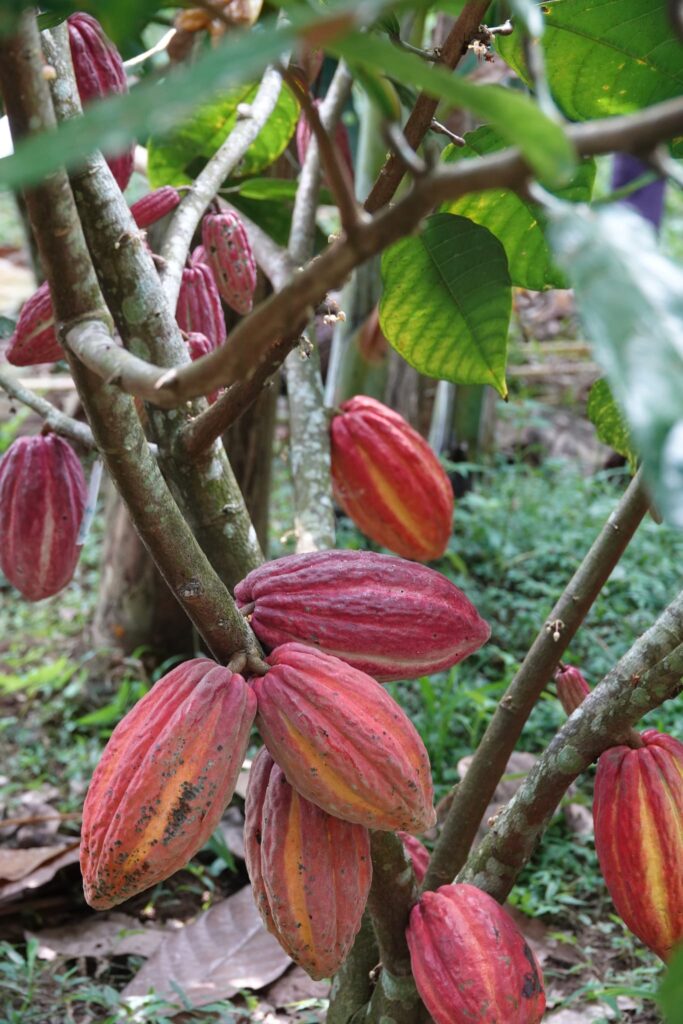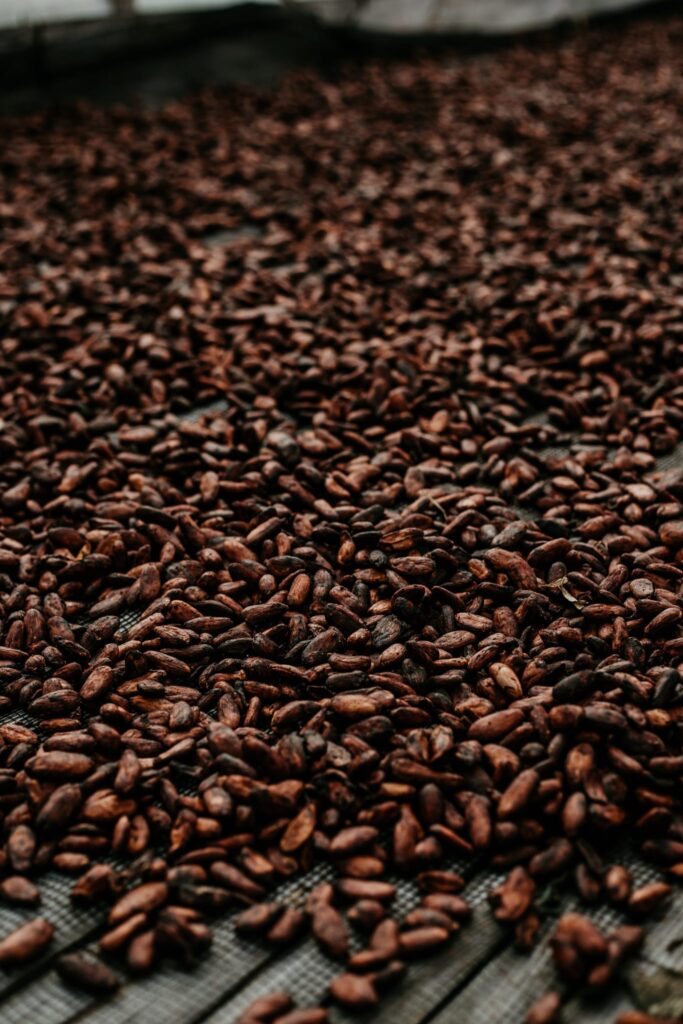
Beyond its culinary appeal, ceremonial cacao has served as a therapeutic tool throughout the world. This essay explores the benefits of cacao and its history. Additionally, it examines the utilisation of ceremonial cacao in the context of psychotherapy and highlights the need for ethical practice and ethical cacao producers.
Introduction
For centuries, cacao, commonly known as chocolate, has been valued for its rich flavour and enticing aroma. Ceremonial cacao, derived from the seeds of the Theobroma cacao tree, dates back to ancient civilisations. The Theobroma cacao tree, commonly known as the cacao tree, is a tropical evergreen tree native to the rainforests of Central and South America. It belongs to the family Malvaceae and produces cacao beans, the primary ingredient used in the production of chocolate. Typically growing to a height of 4-8 meters, it has large, glossy leaves. Its flowers are small and pinkish, growing directly on its trunk and branches. These flowers develop into large, footballshaped fruits called cacao pods. They range in colour from yellow to orange or red when ripe. Inside the pods are the cacao beans, embedded in a sweet, white pulp. The beans are harvested, fermented and dried before being processed into various forms, including cocoa powder and chocolate (León-Roque et al., 2019; Motamayor et al., 2008). Beyond its culinary appeal, ceremonial cacao has served as a therapeutic tool in various cultural and ceremonial practices. This essay explores these benefits, delving into its historical significance and current use.
Cacao facilitator training in Ireland
Since there is currently no regulatory body in Ireland for cacao facilitator training, it is crucial that you choose a teacher who is well-versed in ceremonial cacao, has experience working with indigenous people, understands ethics when teaching the ways of working with cacao, and will offer continuing support. The course should be well researched and be traceable through the linage of the cacao. The training should centre on your own inner journey. In order to assist others, you must first undergo a deep healing and evolution within yourself. I did a six-month immersive ceremonial cacao facilitator training course which equipped me with the knowledge, tools, and experience to confidently speak about ceremonial cacao and hold others in transformational sacred space. This immersive course focused on facilitating ceremonial cacao offerings, helping others connect deeply to their inner world, developing relationships with ceremonial cacao, creating safe spaces, and holding people in expansion and contraction Since training, I continue to develop my knowledge of the cacao and its uses participating in ceremonies and Dietas with ceremonial cacao regularly and meeting indigenous people who blessed this cacao.
Ethics in practice
Ceremonial cacao is a sacred practice that requires a thoughtful and ethical approach (Wilkes, 2014). Key considerations include obtaining informed consent from clients, conducting thorough health screenings, setting intentions, recognising individual needs, having appropriate qualifications and training, choosing ethically sourced cacao products, maintaining open communication, offering postceremony support, respecting cultural traditions, and conducting continuous assessments. I am covered by the OBF for therapy services. This insurance pertains to traditional talk therapy sessions, which are conducted following the guidelines set by the IACP. I have a separate insurance policy with the same provider to cover ceremonial cacao facilitation. This recognises the distinctive nature of cacao ceremonies and ensures appropriate coverage for potential risks associated with this particular practice. Informed consent ensures that clients understand the nature of the ceremony, potential effects, and risks involved. Client screening helps identify any pre-existing medical conditions or medications that may interact with cacao. Intention setting ensures that clients’ intentions align with the purpose of the session.
A personalised approach is created. Qualifications and training in ceremonial cacao practices contribute to a safe and beneficial experience for clients. Ethical sourcing ensures that cacao products are produced ethically, and open communication promotes trust and collaboration. Post-ceremony support ensures that clients’ wellbeing is considered beyond the immediate experience. Cultural sensitivity ensures that cultural practices are respected, and the ceremony remains sacred. The ceremonial space should be conducive to a positive and safe experience, with guidelines for lighting, seating arrangements, and overall ambiance. Clients should be psychologically prepared for the emotional and introspective aspects of the ceremony. Support should be provided for post-ceremony integration, offering structured support to help clients effectively process and integrate their experiences into their daily lives. Ceremonial cacao is generally safe for most individuals, but there are certain contraindications (MartanezPinilla et al., 2015).
These include heart-related issues, migraines or headaches, pregnancy and breastfeeding, and certain mental health conditions should be consulted with a healthcare professional. Cacao contains theobromine, a stimulant similar to caffeine, which may exacerbate digestive issues in some individuals. Cacao may also interact with certain medications, such as antidepressants and antipsychotics (Nehlig, 2013). Cacao’s high fibre and fat content may exacerbate digestive issues in some individuals. Clients with low iron levels or irondeficiency should avoid consuming cacao around mealtimes. Children should consult a paediatrician before introducing cacao to their diet. Individual responses to cacao can vary, so it’s crucial for those with specific health concerns or conditions to consult a healthcare professional before incorporating ceremonial cacao into their routine.
Ethical sourcing practices are essential for sourcing cacao ethically and sustainably, choosing suppliers and products that align with ethical standards. Maintaining open and transparent communication with clients throughout the process promotes trust and collaboration. Post-ceremony support should include creating a space for reflection, addressing questions or concerns, and providing resources for integration. Cultural sensitivity is crucial (Cacao, n.d.), as it involves being mindful of the cultural origins of ceremonial cacao and respecting its traditions. Regular assessment of the client’s comfort and well-being during the ceremony is necessary to adapt the session based on feedback and needs. By incorporating these ethical considerations and assessment criteria, facilitators can work towards ensuring the ceremonial cacao experience is meaningful and in the best interest of their clients.
Supervision
In mental health and counselling, clinical supervision is essential because it gives practitioners continuous support and direction. Seeking continuous support is crucial for practitioners and their clients in Ireland, as clinical supervision for cacao facilitators is not currently accessible. My supervision of talk therapy adheres to the guidelines set by the IACP. The ceremonial aspect of the session, involving cacao facilitation, is approached differently. Instead of formal clinical supervision, I discuss specific aspects with a mentor when needed. This mentorship provides guidance and support related to the serving and preparation of the ceremonial elements but does not involve discussing client-specific details. It focuses more on the procedural and ceremonial aspects of the practice. Alternative strategies include participating in online communities, forming supervision groups with trainers and mentors, fostering reflective practice, obtaining advice from seasoned colleagues, ongoing training, becoming a member of professional associations, forming mentorship relationships and creating therapist support networks. These techniques help practitioners and clients feel supported, guided, and part of a community.
Cacao’s historical significance
Cacao dates back thousands of years, with evidence of its cultivation and consumption by ancient Mesoamerican civilisations, such as the Mayans and Aztecs. The Mayan civilisation was one of the most renowned pre-Columbian societies in Mesoamerica. Mayans cultivated cacao trees and revered the beans for their rich flavour and medicinal properties. Archaeological evidence, including pottery vessels and hieroglyphic inscriptions, attests to their appreciation of cacao. These artefacts depict cacao being consumed as a beverage during royal ceremonies and as a currency. The Popol Vuh, the sacred Mayan text, contains references to cacao as a sacred food associated with the gods (Coe & Coe, 2019; McNeil, 2013). They say Maya and Aztec civilisations regarded cacao as a sacred plant with spiritual and ceremonial significance. This including offerings to deities and a means of communication with the supernatural realm. The indigenous peoples recognised the therapeutic and ceremonial significance of cacao. Cacao was believed to possess mystical and healing properties, enhancing spiritual experiences, and promoting emotional wellbeing. The widespread adoption of cacao ceremonies declined when European colonisers transformed its consumption into a commodity. Colonisation led to the eventual destruction of Mayan civilisation’s use of cacao (Coe & Coe, 2019). Spanish conquistadors in the 16th century brought significant changes to Mesoamerica, including the introduction of new economic systems and cultural practices. The colonisers recognised the value of cacao and exploited it. They implemented new plantation systems and imposed heavy taxes on cacao production, causing significant disruption to the traditional Mayan cacao cultivation and trade networks (Presilla, 2009). The forced labour and harsh working conditions imposed on the indigenous population by the colonisers resulted in a decline in agricultural practices, including cacao farming (Coe & Coe, 2019). The disruption of Mayan cultural practices and economic systems, combined with disease epidemics brought by the Europeans, contributed to the decline and eventual demise of the Mayan civilisation’s use of cacao (McNeil, 2013). The recent resurgence of interest in cacao ceremonies honours the potential therapeutic benefits. Arévalo (2018) highlights contemporary approaches to ancient rituals. This revival demonstrates a renewed appreciation for the cultural and historical significance of cacao.
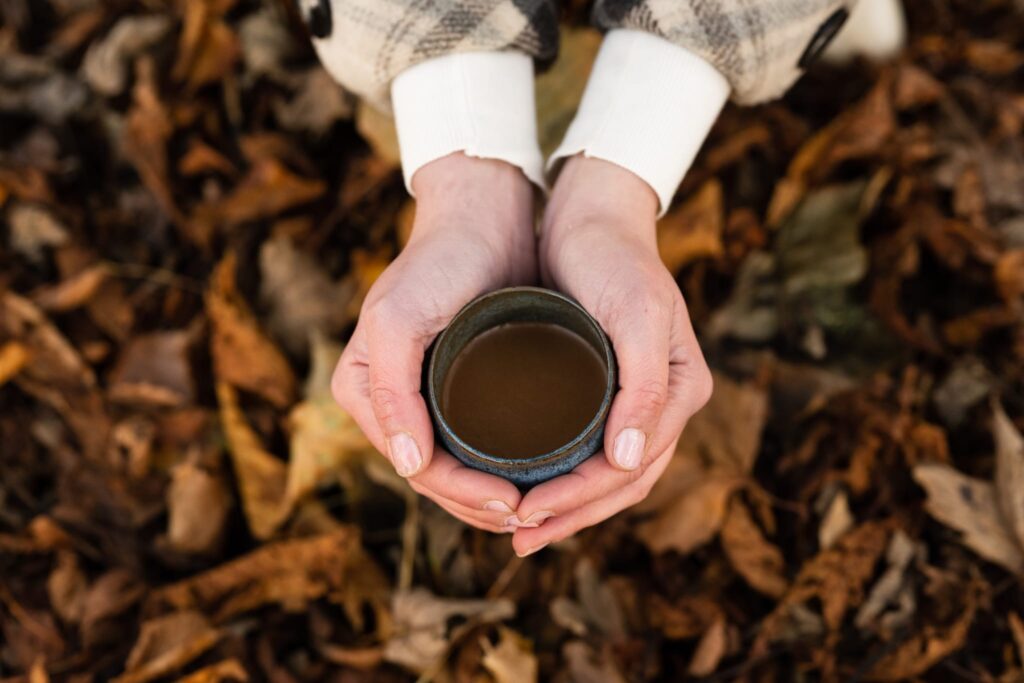
Health benefits
Modern research has shed light on the numerous health benefits associated with cacao. Compared to other “superfoods” like acai, blueberries, tea, and pomegranates, cacao has more antioxidants (Crozier et al., 2011). The health benefits of cacao, specifically its richness in flavonoids, have been extensively studied. Flavonoids are recognised as powerful antioxidants that play a crucial role in reducing inflammation and protecting against oxidative stress. These properties have been linked to the prevention of various chronic diseases, notably cardiovascular ailments, and certain types of cancer. Numerous scientific studies support this understanding. For instance, a study published in the Journal of Nutrition (Arts et al., 2001) demonstrated the anti-inflammatory effects of flavonoids, contributing to the potential prevention of chronic diseases.
Additionally, research in the Journal of the American College of Cardiology (Rimm et al., 2007) highlights the association between flavonoid-rich foods, like cacao, and a reduced risk of cardiovascular diseases. This body of evidence underscores the valuable role of cacao-derived flavonoids in promoting overall health and potentially preventing serious medical conditions.
Furthermore, cacao contains various compounds that stimulate the release of endorphins and neurotransmitters, such as serotonin and dopamine, in the brain. These chemicals are associated with positive emotions, promoting feelings of happiness, pleasure, and relaxation. Cacao contains various neurochemical compounds that can positively impact mental health Katz et al., 2011). Phenylethylamine (PEA), often referred to as the “love molecule,” promotes feelings of happiness, pleasure, and wellbeing. Anandamide, known as the “bliss molecule,” is a natural cannabinoid that activates specific receptors in the brain associated with mood regulation and stress reduction. Perhaps this is why it was known as “the food of the Gods” by indigenous people (Cuppens & Pham 2019). Additionally, cacao is a natural source of theobromine, a mild stimulant that can improve focus, enhance cognitive function, and alleviate symptoms of fatigue (Martínez-Pinilla et al., 2015).
Ceremonial cacao and psychotherapy
In recent years, a unique approach known as “cacao therapy” has gained popularity (Martín et al., 2008). These cacao ceremonies involve the consumption of highquality, pure cacao in a safe and intentional setting under the guidance of a trained cacao facilitator. The psychotherapeutic potential of cacao ceremonies lies in their ability to enhance emotional connection, promote mindfulness, and facilitate personal transformation. Prendergast (2018) explores the role of cacao ceremonies in facilitating connection and emotional healing. The ritualistic consumption of cacao in a ceremonial setting allows individuals to deepen their awareness, access their emotions, and engage in selfreflection. This heightened state of consciousness can support the psychotherapeutic processes, enabling individuals to explore unresolved issues and promote healing. As a psychotherapist dedicated to my client’s wellbeing, I am passionate about exploring innovative approaches that can enhance the psychotherapeutic journey together. Incorporating ceremonial cacao into sessions can be transformative and beneficial for emotional wellbeing for several reasons.
Ceremonial cacao provides a unique opportunity for deepening the therapeutic experience. Its ancient origins and sacred ceremonial traditions create a sacred space for introspection, healing, and personal growth. The therapist creates a safe and intentional environment for the client to explore emotions, fears, and aspirations with enhanced clarity and compassion. Ceremonial cacao has been revered by ancient civilisations for its heartopening properties (Prendergast 2018), and this quality holds great significance in building a strong therapeutic alliance. We often delve into the depths of emotions, examining wounds and traumas that may have been buried within. Ceremonial cacao acts as a gentle yet powerful facilitator, inviting an openhearted approach to these emotional landscapes. It fosters self-compassion and self-acceptance, allowing you to navigate challenging emotions with greater ease and grace. In the presence of ceremonial cacao, the mind-body connection is nurtured and heightened. The bioactive compounds found in cacao, such as theobromine and anandamide, work synergistically to enhance cognitive function, focus, and overall well-being (Nehlig, 2013).
The ceremonial cacao is a compassionate ally that supports your ability to remain grounded, centred, and present throughout the therapy sessions. It functions as a link between your inner self and the outside world, allowing you to integrate your experiences and ideas more completely. Ceremonial cacao can improve mood and strengthen emotional defences. Endorphins and other neurotransmitters, including serotonin and dopamine, linked to emotions of happiness, pleasure, and relaxation, are released when you consume cacao. This elevating impact can be especially helpful for overcoming difficult emotional states, such as despair or anxiety (Fusar-Poli et al., 2021).
Ceremonial cacao can lift the spirits and cultivates a sense of inner power while gently promoting emotional wellbeing. Creating an environment where emotional healing and vulnerability may occur is frequently at the heart of the therapeutic process. Ceremonial cacao can lead to great inner transformation and self-discovery. You ask the age-old wisdom of ceremonial cacao to lead you on a path of introspection and self-compassion as you drink the warm nectar. The ceremonial quality of this practice allows you to accept the beauty of your path, celebrate your perseverance, and acknowledge your emotions.
During cacao therapy sessions, individuals are invited to connect with the present moment, their emotions, and their inner selves. The ceremonial use of cacao can create a meditative state, enhancing mindfulness and introspection. The combination of the bioactive compounds in cacao, along with the ritualistic experience, can facilitate emotional release, foster self-reflection, and promote a sense of self. We co-create an environment where recovery is emphasised and authenticity is cherished. We may approach our therapy work with more awareness and connection because the ceremonial cacao rituals serve as a gentle reminder of the power of intention and presence. Together, we set out on a path that cultivates healthy mental health from a holistic perspective by fusing the knowledge of psychotherapy with the age-old customs around ceremonial cacao. Before we start this special therapy technique, we will have a full conversation to assess suitability. Ceremonial cacao therapy must be individualised, considering factors like client sensitivity, body weight, and previous experiences. Our shared goal is to create a therapeutic space where you feel empowered, supported, and nurtured in your journey towards positive mental health.
Cacao’s neurochemical composition, including compounds like theobromine, phenethylamine, and anandamide, has been linked to enhanced mood, increased focus, and improved cognitive function. These properties contribute to the potential therapeutic effects of cacao, making it a valuable adjunct to psychotherapeutic interventions. Serotonin, a neurotransmitter linked to mood regulation, is often lower in individuals with conditions like depression and anxiety. Consuming cacao can elevate mood and reduce symptoms associated with these disorders (Tomen, 2023), (Cuppens and Pham 2019). The decision to introduce ceremonial cacao into therapeutic practice is rooted in the acknowledgement of its potential to create a unique and transformative space. As Kunzli notes, “The ceremonial use of cacao can be a powerful modality for emotional exploration and healing” (2023).
Mindfulness and emotional regulation
Coe & Coe (2013) suggested that ceremonial cacao ceremonies often incorporate mindfulness practices such as meditation, breathwork and visualisation. These techniques enhance emotional regulation and promote a sense of being grounded allowing individuals to explore and process challenging emotions in a supportive environment. The combination of ceremonial practices and cacao’s psychoactive compounds creates a conducive atmosphere for self-reflection and emotional healing. A 2012 study by (Pase et al., 2013) investigated the long-term effects of cacao polyphenols on cognition and mood. The study involved 72 healthy middle-aged participants who received a dark chocolate drink mix containing different doses of polyphenols daily for 30 days. Results showed that a high dose of cacao polyphenols improved calmness and contentedness, suggesting potential long-term effects of these polyphenols.
Heart-opening and connection
Ceremonial cacao is known for its heart-opening properties, fostering feelings of love, empathy, and compassion. In a therapeutic context, indigenously sourced ceremonial cacao can facilitate the development of a deeper connection with oneself and others, enhancing empathy and interpersonal relationships. This can be particularly beneficial for individuals struggling with attachment issues, trauma or social isolation (Martin, 2019).
Integration and personal growth
The introspective nature of ceremonial cacao experiences allows individuals to gain insights, cultivate self-awareness, and navigate personal challenges. The integration of these experiences into psychotherapeutic processes can support long-term personal growth, self-empowerment and transformation. Ceremonial cacao acts as a catalyst for self-discovery and facilitates the exploration of one’s inner landscape (Burby, 2021). Ethical cacao producers Guatemala, a country rich in Mayan heritage and traditions, is known for its high-quality cacao beans. Evoke Cacao, an organisation dedicated to ceremonial cacao, say Guatemala is one of the “holy grails” of ceremonial cacao production (Evoke Cacao, 2021). Guatamala’s cacao is highly regarded for its spiritual and energetic properties, making it a sought-after choice for ceremonial purposes. Peru also has a deep connection to cacao’s historical and cultural significance. Peruvian cacao has been used in sacred rituals by indigenous communities, such as the Shipibo-Conibo and the Ashaninka. Cacao Magazine say Peru has seen a resurgence in ceremonial cacao practices, with a focus on sustainable and ethical production (Cacao Magazine, 2020). The country’s commitment to preserving the ancestral knowledge and rituals associated with cacao makes it a significant player in the ceremonial cacao market.
The Caribbean island Belise is renowned for its rich cacao traditions. The Mayans considered cacao a sacred plant and Belisean cacao has deep historical and cultural roots. The Toledo Cacao Growers Association (TCGA) in Belize is dedicated to producing high-quality ceremonial cacao while supporting small-scale farmers and preserving traditional Mayan practices. According to the TCGA, Belizean cacao holds a special place in the ceremonial cacao world, known for its unique flavours and the spiritual experiences it can evoke (Toledo Cacao Growers Association, In Ireland, Vivienne and Patrick founded Saoro, an online community where individuals may interact with one another while pursuing spiritual and mental wellness. They produce Premium Ceremonial Cacao, originating from Bali’s stunning Paradise Island. They were inspired by the sacredness of “the Island of the Gods” where shamanic Hinduism, an older branch of the religion, is practised. Daily life feels sacred in Bali.
Many people maintain shrines in their gardens for daily prayers, offerings, and meditation. The earth and the human mind are profoundly ingrained with the energies of the Hindu Gods and Goddesses Shiva, Kali, and Ganesh. Beautiful temples include a mix of pristine white beaches and high mountain jungle. This exquisite cacao has a lovely high frequency like the country from where it originated. It is a true balm for the heart and soul. Saoro’s cacao beans come from the Ubud district of Bali, a traditional hub of crafts and dance surrounded by lush rainforest, famous terraced rice terraces and sprinkled with old temples and shrines. The Mason family in Bali produce sustainable cacao for Saoro. The essence of cacao as a sacred plant is integral to its role in ancient rituals and ceremonies. The Masons’ dedication to preserving ancestral knowledge and sustainable production practices means they continue to provide ceremonial cacao of exceptional quality, promoting spiritual exploration and personal transformation.
Conclusion
Cacao, with its rich history and numerous health benefits, is emerging as a valuable therapeutic tool. Its cultural significance and physiological effects make it a powerful ally in promoting emotional wellbeing, mindfulness, and selfreflection. While cacao therapy is not a standalone treatment, it can be a complementary approach that enhances the therapeutic process and facilitates personal growth. As research continues to unfold, professionals in the field of mental health can explore and potentially integrate innovative approaches like cacao therapy to expand the possibilities of healing and transformation. By harnessing the ancient wisdom surrounding cacao and combining it with modern therapeutic practices, we can tap into the potential of this remarkable substance to enhance the wellbeing of individuals seeking support and growth in their psychotherapeutic process. It is important to source ceremonial cacao from reputable distributors, as this ensures the quality, authenticity, and ethical standards of the cacao. By doing so, we support sustainable practices, cultural preservation, and the wellbeing of the communities involved in the cacao supply chain. It enhances the ceremonial experience, promotes responsible consumption, and fosters a deeper connection with this sacred plant.
As a counsellor, psychotherapist and certified cacao facilitator, Siân focuses on giving her clients the confidence to follow their own intuition and discover purpose in life. She is enthusiastic about integrating ceremonial cacao into therapy due to its potential to create a unique and profound therapeutic space, fostering emotional exploration and openness. The sensory and ritualistic aspects of cacao ceremonies offer a novel approach to enhancing mindfulness and presence in sessions, contributing to a deeper client-therapist connection. Siân’s approach to her work is holistic, humanistic, and integrative. She draws from several therapeutic theories such as Gestalt, PersonCentered, and Existentialist. Siân’s specialisms include spirituality, addiction, recovery, couples work, family constellations, trauma recovery and crises related to meaning and purpose. In addition to her counselling and psychotherapy, Siân integrates Kundalini, Reiki and Shamanic healing as appropriate.
Contact: www.satnamtherapy.com / @satnamtherapy
